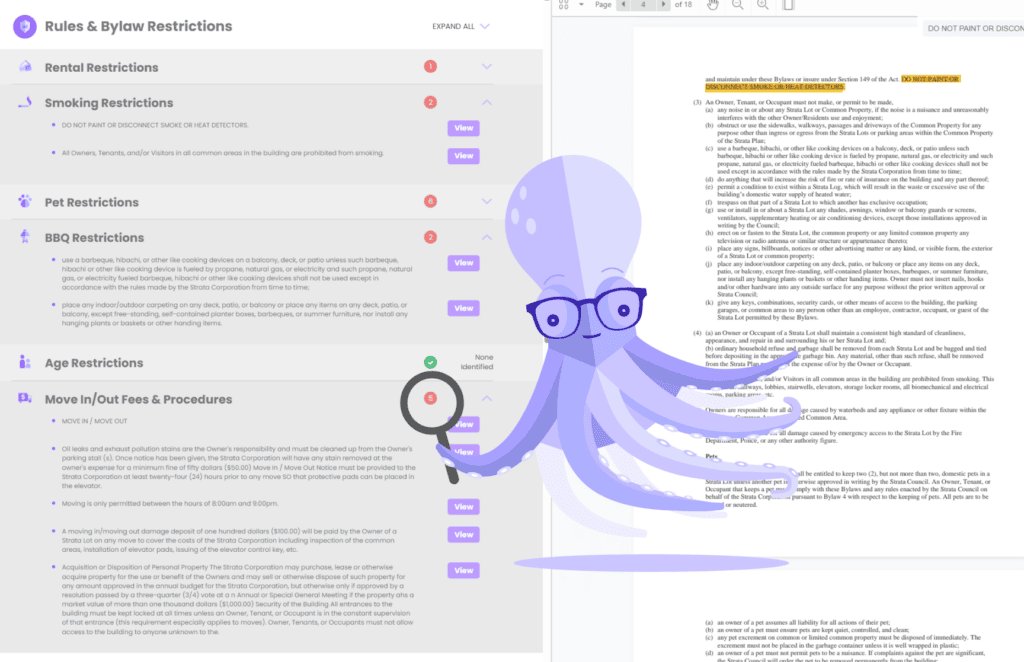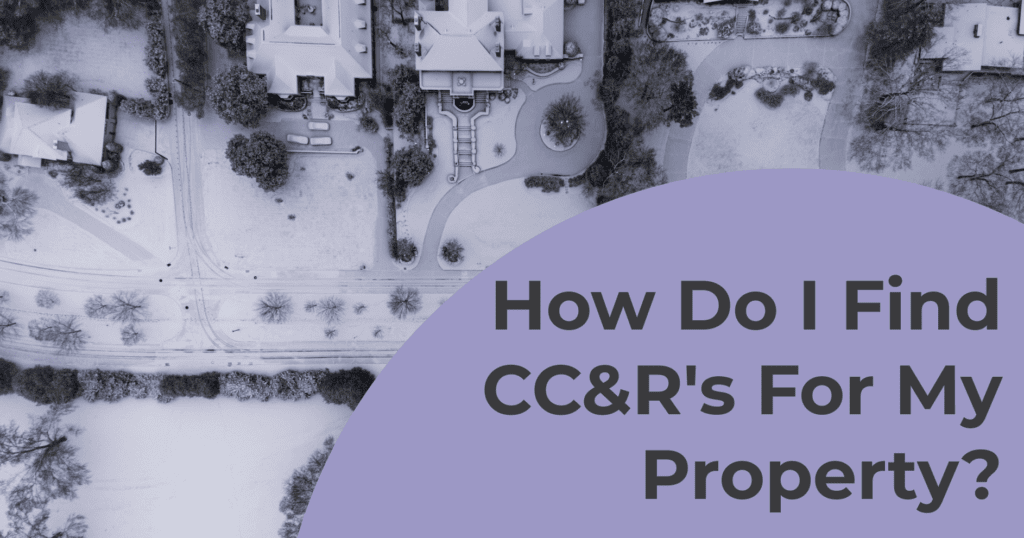If you’re looking into buying a property within a homeowners association (HOA) or need to review important rules and regulations about your HOA, knowing the CC&R’s document is essential.
In this article, we’ll go over what the CC&R’s cover, how to conduct HOA Document Reviews as an owner or prospective buyer, what to analyze, and how to be confident in your review.
By the end you’ll be comfortable navigating CC&R’s and other HOA documents by understanding important details. Let’s dive in.
Table of Contents
How to Find CC&R’s for Your Property as an Owner
Finding CC&R’s When Buying a Property
What are CC&R’s?
In short, CC&R’s stand for Covenants, Conditions, and Restrictions. These are legally binding rules set by a developer or HOA to manage how properties in a community are used and maintained.
These rules help keep the neighborhood looking consistent to a certain set of standards across all properties in the HOA.
Examples of CC&R’s
Let’s dive into an example so you can better understand how CC&Rs work. Let’s say you’re thinking of painting your home. Exterior paint colors may be restricted so all homes match a certain style or color palette, meaning you can’t paint your house bright pink if the community requires neutral colors.
Or if you have a big RV or boat, parking rules often regulate where vehicles can be parked, such as prohibiting RVs, boats, or trailers in driveways or on the street for certain times of the day or year.
Why You Need to Understand These
It’s important to find and review the CC&R’s for your property to avoid fines or penalties for breaking the rules, understand what is and isn’t allowed, and ensure you’re following the rules when planning any changes or improvements to your home.
The last thing you want when buying into a new neighborhood is dealing with CC&R’s that don’t align with your lifestyle. Or buying into the wrong HOA that has extremely strict rulings, like some of these people have experienced.
What’s your “nightmare HOA” story?
byu/bookluvr83 inAskReddit
How to Find CC&R’s for Your Property as an Owner
If you already own the property, you can find these documents by reviewing your existing records or reaching out to the appropriate parties.
Step-by-Step Process for Property Owners
1. Review Your Closing Documents
To find the CC&R’s for your property, start by checking your closing documents. When you bought your home, the professionals that helped with the closing and title changes (a notary or lawyer) should have provided these rules as part of your title or deed packet.
Look for a section labeled something like “Declaration of Covenants, Conditions & Restrictions.”
2. Check Your Property Deed or Title Documents
If you can’t find them there, check your property deed or title documents. Since CC&R’s are legally recorded with your deed, you can often locate them in your property’s records, either as a digital file or a paper copy.
3. Contact Your Homeowners Association (HOA)
If you live in a neighborhood with a HOA, the HOA will have the most up-to-date version, so get a copy from them.
Simply call or email your HOA manager or board and ask for a copy. They may want to confirm certain details before providing this information like your property address and HOA membership information.
5. Search Public Records at the County Recorder’s Office
As a last resort effort, you can also search for CC&R’s at your local County Recorder’s Office. It’s not considered public information, but is available upon request.
There are several areas where you can find the CC&R’s if you’re already an owner.
Recommended Reading: The Pros & Cons of an HOA
Finding CC&R’s When Buying a Property
If you’re considering purchasing a property, reviewing the CC&R’s before making an offer is essential to make sure there is a fit for you and the HOA.
There is a bit of a different process to follow to find CC&R’s when you’re potentially buying the property and don’t have an existing relationship with the HOA or current owner.
Step-by-Step Process for Potential Buyers
1. Request the CC&R’s from the Listing Agent or Seller:
One of the simplest ways to obtain the CC&R’s for a property is by requesting them directly from the listing agent or seller. Ideally, this is all you’ll need to do if it’s a good HOA with a reliable listing agent.
During the home-buying process, sellers or their agents are usually obligated to disclose these documents, along with other key materials.
As a buyer, if you’re working with a Realtor or agent, they’ll be able to gather these documents for you and should be doing so for every home that you’re considering in an HOA. Including this step in your due diligence process will make sure you have time to review CC&R’s accordingly, before you make an offer.
2. Contact the Homeowners Association (HOA):
If you’re buying a home without a Realtor or agent, and the seller isn’t providing the documents, but you still want to move forward, you can contact the HOA directly.
They’ll be able to provide all documentation like other bylaws, financial statements, meeting minutes, and more. It’s best to request all documents in one go to avoid missing documentation or longer timelines for receiving important documents.
3. Review Public Property Records at the County Recorder’s Office:
Similar to owners, if you cannot get ahold of the CC&R’s and other important documents from the HOA, you can make a request at your local County Recorder’s Office. Sometimes there are online tools to allow you to make these requests, but you may have to locate the local office in the city you’re buying in and make a stop there.
Receiving these documents should be as easy as requesting them from the seller or your buying agent. Then allocate more time to actually analyzing these documents (which can be done in minutes, with Eli Report).
Recommended Reading: Are homeowner associations nonprofit?
What to Look for in Your CC&R’s
So, now that you’ve received the CC&R’s, you’ll need to know what to actually review and look for. Focus on these main areas:
Property Use Restrictions
The Property Use Restrictions outline what you can and cannot do with your home, such as rules about pets, exterior decor, parking, outbuildings, noise levels, or business operations.
What to Look For: Check for restrictions that may impact how you foresee your life at that property. For instance, if you run a home-based business, is that allowed? If you have pets, are they allowed? What about parking? We recommended taking some time to think about the next 10 years of your life and how these rules may affect you negatively or positively.
Architectural Guidelines
Next, examine the Architectural Guidelines, which govern modifications or additions, such as building a fence, repainting, or adding a structure.
What to Look For: Again, similar to the property-use restrictions, it’s important to review rules for exterior changes like repainting, building fences, or adding outbuildings structures like sheds or gazebos. What you want to avoid are rules that may adversely affect your future lifestyle on that property.
Fees and Assessments
Pay close attention to the section on Fees and Assessments, as this details your obligations to pay HOA fees.
What to Look For: Find the amount and frequency of HOA fees, how special assessments are handled, and penalties for late payments. These are very important for any monthly budget considerations. As well as to see if there are frequent changes in these fees or assessments.
Violation Enforcement Policies
The CC&R’s should also outline Violation Enforcement Policies to explain how the HOA enforces compliance and what penalties you might face for breaking the rules.
What to Look For: It’s important to review the types of penalties imposed (fines, legal action, or even property liens), and whether there is an opportunity to dispute or appeal enforcement actions. An overly enforced HOA or one that imposes large fines or litigations can be a nightmare to live in.
Rental and Lease Restrictions
Finally, look into Rental and Lease Restrictions, which could limit your ability to rent out the property on a short or long-term basis.
What to Look For: Note any restrictions on short-term rentals, such as Airbnb, or requirements for long-term leasing, such as minimum lease terms or tenant screening. Some HOAs may limit the number of properties that can be rented within the community. You may not be thinking about renting out your home now, but if it’s a future possibility for you, these will be important to review.
Recommended Reading: Buying into an HOA? You are your own fiduciary!
The Easy Way to Review CC&R’s and Other HOA Documents in Minutes!
Typically, reviewing CC&R’s is a manual and tedious process, sitting down and sifting through a bunch of paperwork, one by one. A painful process that typically takes hours of your time, especially when you’re reviewing several properties.
Now, with Eli Report, you can use AI-powered software to help you automate your HOA document review process. Analyzing all documents, not just CC&R’s to get valuable insights in minutes.
Here is how:
Step 1: Upload the Documents
Start by gathering the CC&R’s and other HOA documents, which you can request from the seller, HOA, or your title company. Once you have the files:
- Log in to your Eli Report account.
- Upload the documents directly into the platform—PDFs or scanned copies work perfectly.
Eli Report’s easy-to-use interface makes it easy to upload and organize files, eliminating the hassle of manually sorting through pages of legal text.
Step 2: Let Eli Report Analyze the Documents
Once uploaded, Eli Report’s powerful analysis takes over. The platform automatically scans and processes the documents, extracting essential information for you, in minutes.

Step 3: Review the Simplified Report
In just minutes, Eli Report generates a comprehensive, easy-to-read summary of the CC&R’s and other HOA documents. The report includes:
A High-Level Overview: Summarizing the key obligations and rules within the documents.
Highlighted Critical Rules: Drawing attention to the most impactful restrictions or requirements.
Eli Report simplifies the document review process, ensuring you understand the fine print before buying or moving forward with a property. Whether you’re a buyer, agent, or investor, this tool is designed to save time and provide peace of mind with every transaction.
Final Thoughts
As you can see, the steps to actually finding your CC&R’s documents should be quite simple. The work involved is mainly around the analysis of these documents, along with other important HOA documents.
And without a serious review, you could end up living in a neighborhood you resent, because of the existing rules and structures in place.
That’s why, if you need help reviewing your HOA documents, use Eli Report’s free first report to get insights in minutes. Get started here.
